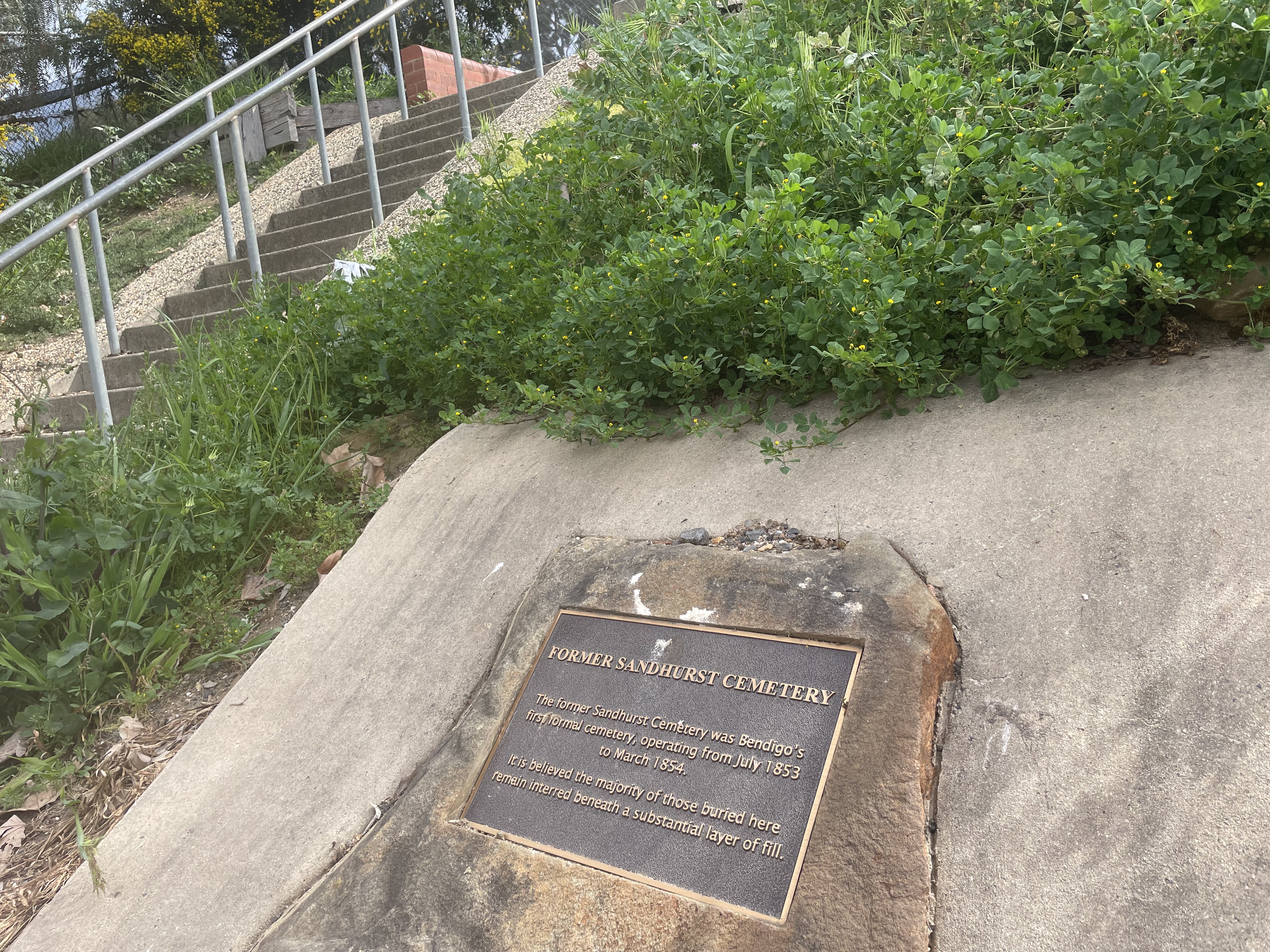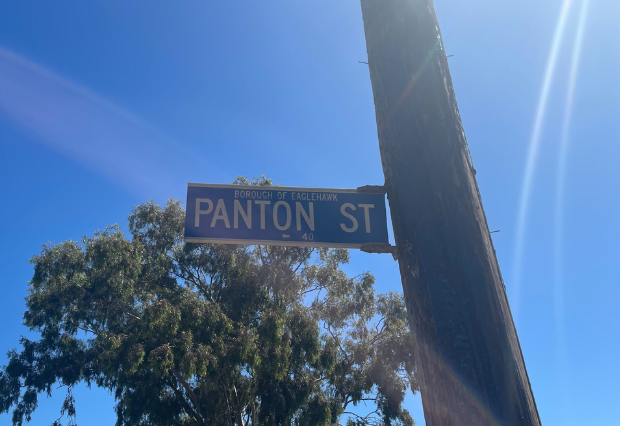A group of women run back and forth across an empty car park as the flying foxes settle in to roost at dawn. A few early-rising exercisers run ahead, while some barely make it to the other side before the group turns back the other way. As these women run, they are wholly unaware of who rests below their feet.
To one side of the carpark is a tall chain-link fence and an easily missed staircase. It leads down to the end of Cemetery Street, where, out of sight, between a funeral home and the Golden Dragon Museum, threatened by dense weeds if not for the protection of a generous concrete border, sits a plaque for the former Sandhurst Cemetery.
Bendigo’s first formal cemetery, then called the Sandhurst Burial Ground, operated from July 1853 to March 1854. Now, what is left of it, lies under the carpark where the women are doing their interval training. The plaque, which we’d typically expect to tell us concrete facts of exactly what it is commemorating, instead seems unsure of the details.
“It is believed the majority of those buried here remain interred beneath a substantial layer of fill,” the plaque says.

The history of how many remain buried under this site is unclear. Estimates put it between 200 and 1000. These are Bendigo’s early non-indigenous settlers. While their names and histories are lost, we know the majority were Chinese. These are the people who weren’t exhumed like Quang Yang, who was carefully dug up and sent back to China in the late 1860s to be buried in his home village and among his ancestors. Instead, these are the people left when Bendigo erased much of the Chinese presence in the town’s history from the late 1800s through to the 1960s when the Bridge Street Chinatown was demolished. According to Adam Holmes, a writer for Bendigo Advertiser, historical documents and living memory accounts suggest that the old tombstones that once marked the graves were used as pavers on surrounding laneways.
The site is one example among many of a tradition of ignoring Chinese people’s historic presence in this town outside of the iconic Easter Parade, where traditional lions and imperial dragons take to the streets in an act of bringing the community together across cultures.
Bendigo is a city where you can walk through history from a streetside curb. The town’s goldrush past, which turned it from “sheep station into a bustling town”, is preserved in historic buildings and in the names of streets that they’re found on. Street names tell a story about a place and what the community views as important at the time.
Like the initial erasure of Bridge Street China Town and its original architecture from Bendigo’s streetscape, Chinese people who have been important to the town’s history are absent from the story that has been written by its street names.
Archives Coordinator Susan Walter at the Bendigo Regional Archives Centre says streets in the region were first named by surveyors who broke up things like squatters runs. Later, as townships grew, a small portion of the area set aside would be subdivided and the local councillors would suggest road names.
“So now you start to see the road names named after the local councillors and the former mayors and some of the wealthier families,” she says.
One Bendigo figure who has been commemorated with a street name is Joseph Anderson Panton, who was the Victorian goldfields’ commissioner and Melbourne’s chief magistrate. He was described after his death as having a “handsome face and soldierly bearing” and that “his tact and firmness” prevented a Eureka on a ‘much bigger and more dangerous scale than at Ballarat”. Considered at one time one of the “most familiar figures in Melbourne”, Panton Street in Bendigo’s Golden Square would be named after him while he was commissioner in the town.
Panton should also be remembered for suggesting what came to be known as the Protectorate System, which aimed to address growing tensions between Chinese migrants and Europeans. This would, in theory, be remedied by establishing a “camp system” that was “best calculated to suit the interests of both parties”. In practice, it placed heavy taxes on Chinese people, and officially segregated the migrant group as a means of “protection”.
In Victorian gold mining towns such as Bendigo, at the peak of migration in the 1850s, one in five men were Chinese. The migration trend was perceived to be such a threat that Panton wrote in his memoir that he had spoken with Sir Charles Hotham, the first Governor of Victoria, “on the necessity of providing some means of arresting or checking the influx of Chinese on the goldfields”.
Meanwhile, Panton suggested that a Chinese protectorate system would raise “a revenue from these people only” through an exploitative tax that only strengthened wealth disparity. Legislation such as the Lands Acts of the 1860s allowed their residence license to be revoked at any time without compensation leading to the Chinese population erecting temporary shacks they often lived in for years.
Meanwhile, since those days, Chinese individuals and families who were instrumental to the region’s history have gone unmentioned. Golden Dragon Museum Research Officer Leigh McKinnon tells upstart that he’s disappointed that some of the important figures in Bendigo’s history who were of Chinese heritage, such as herbalist and community leader James Lamsey, lawyer E.J.V. Ni Gan, or interpreter and co-founder of the Chinese Easter Parade James Ah Poo, haven’t been commemorated in our street names.
“I think this is an example of how the significant contributions of the local Chinese community have still sometimes been marginalised, even in Bendigo,” he says.
Today if you walk where Chinese homes and businesses once sat—sites only later documented and honoured by the Golden Dragon Museum—you may see school groups and tours learning about the Chinese community’s history that was so often concreted over.
As perceptions change on how the community reflects on Bendigo’s rich cultural history, we may yet see streets named after the Chinese people integral to it. Walter views councils as moving away from an era where streets were named after “rich white men” or the people that owned the land being subdivided.
“They’re trying to get into a broader spectrum of naming them after women, indigenous people, or maybe the original owner of a piece of land that road now runs along. So, they’re looking for a greater diversity in street names,” she says.
Photos: Provided by author.








